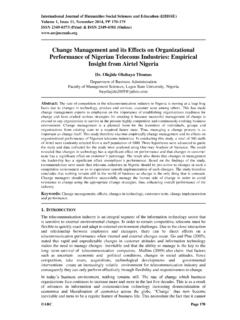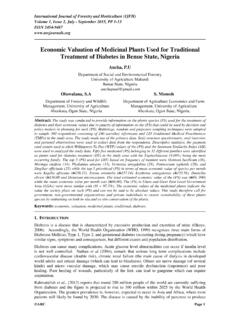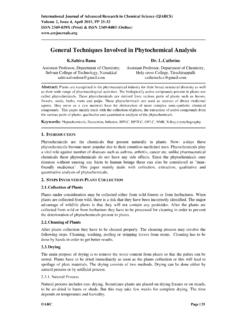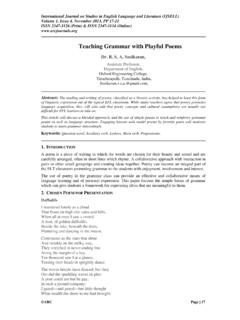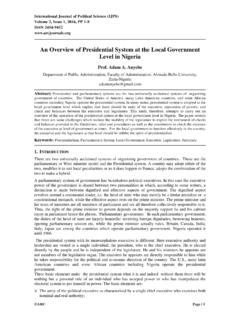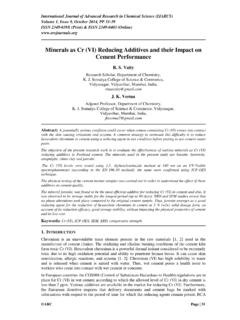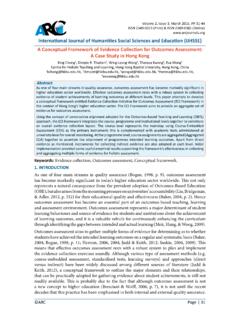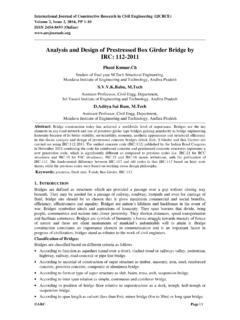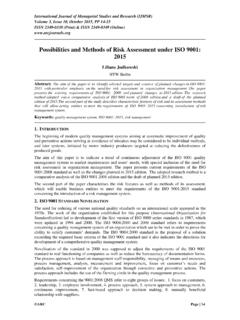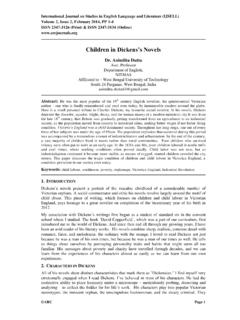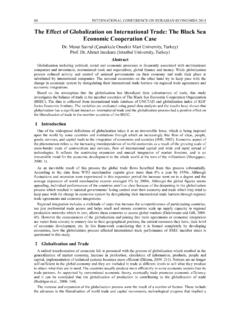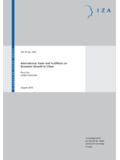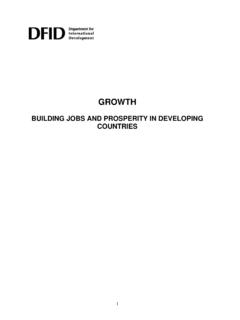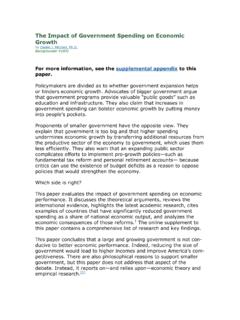Transcription of Economic Growth and Unemployment Relationship: An ...
1 International Journal of Managerial Studies and Research (IJMSR) Volume 4, Issue 12, December 2016, PP 19-24 ISSN 2349-0330 (Print) & ISSN 2349-0349 (Online) ARC Page | 19 Economic Growth and Unemployment Relationship: An Empirical Study for MENA Countries Dr. Ibrahim khrais, Prof. Dr. Mahmoud Al-Wadi Faculty of Economics and Administrative Sciences, Zarqa University, Jordan Abstract: The main purpose of this paper is to examine the relationship between GDP Growth and Unemployment in MENA countries for the period (1990-2016) periods. Simple linear regression used for the analyses.
2 The results indicated that the impact values considered by GDP on the Unemployment in all the countries being involved. The significance level of (F) was greater than ( = ) suggesting no significant impact was observed for gross GDP (annual) representing all the countries being involved in the study on Unemployment in all the countries calculated from labours numbers in these countries. The impact value is considered to be very small (- ). This value suggests that there may be other factor affecting Unemployment other than GDP. Keywords: Unemployment , Economic Growth , GDP, MENA countries. 1. INTRODUCTION Unemployment is regarded as a serious problem faced most developed and developing countries and resulting socio- Economic problems.
3 The governments have given great attention to create job opportunities and reoperation the idle units to eliminate this phenomenon. There are several reasons behind this phenomenon, especially in the developing countries, it is attributed to the shortage of the Economic Growth accompanying with incremental population, inability to mobilize domestic savings in financing desired investments, decline in Economic activity due to recession, changes in technology, changes in consumer demand, on-qualifying employment, which are not commensurate with the changes in labour market. Unemployment usually comes as a result of disequilibrium between demand and supply in the labour market.
4 It is a widely accepted view that the Growth rate of GDP directly affects employment. If it rises, then employment will rise and the Unemployment rate will fall. Many studies confirm the existence of a trade-off between Economic Growth and change rates of Unemployment prevailing in the economy. The main purpose of this paper is to examine the relationship between Unemployment and GDP Growth in MENA countries. The study is structured into 3 sections: section (1) deals with the literature review; section (2) discusses methodology and data; while analysis of results, conclusion and recommendations are presented in section (3). 2. LITERATURE REVIEW The negative correlation between Economic Growth and Unemployment was first stressed by Okun (1962).
5 Following studies have mostly proposed evidence that is parallel to Okun s study. It is possible to group these studies in the literature into two. First group of studies establishes a symmetrical tie between Economic Growth and Unemployment and the second group which also includes the recent studies discusses asymmetrical relationship between Unemployment and Economic Growth . In most of the studies that support asymmetrical relationship between Economic Growth and Unemployment , the main idea is that Economic Growth and Unemployment relationship is more intense in the Economic downturn periods compared to Economic expansion periods. And he proposed that an negative relationship existed between real output level and Unemployment level in his study in which he used data obtained from economy.
6 Eventually, this idea was accepted as Okun s law in the economics theory and it assumed that in the periods when the Economic Growth is over 2, 25%, each 1% increase in real output level caused 0,5% reduction in Unemployment rate. Ibrahim khrais & Mahmoud Al-Wadi International Journal of Managerial Studies and Research (IJMSR) Page | 20 Cuaresma (2003) proposed an asymmetrical relationship between Unemployment and Economic Growth in his study in which he used US Economic data. The author found significant relationship between Economic Growth and Unemployment during Economic shrinkage periods. Silvapulle et al. (2004) stressed that the effect of Economic Growth over Unemployment was more significant during the time of Economic shrinkage in his study in which he used US Economic data between 1947 and 1999.
7 Lee (2000) discussed existence of a strong relationship between Economic Growth and Unemployment in his study which supported Okun s law and was conducted for 16 OECD countries. Malley and Molana (2008) used quarterly data for G7 countries between the years of 1960 to 2001 and they stated that the relationship between Economic Growth and Unemployment was more significant in the case of Germany. Pierdzioch et al. (2011) tested whether professional economists forecasts of changes in the Unemployment rate and the Growth rate of real output were consistent with Okun s law for the period 1989-2007 for G7 and found the Growth rate of real output and Unemployment rate were consistent with Okun s law.
8 Owyang and Sekhposyan (2012) investigated the degree of time variation in the Unemployment and output fluctuations over the business cycle for case. They found a great degree of instability in the historical performance of Okun s law. The breakdowns in Okun s law seemed to be highly correlated with the business cycle. The detected break dates of the largest changes the coefficients appeared to be around recessions. Bankole and Fatai (2013) estimated the Okun s coefficient, and checked the validity of Okun s law in Nigeria, using the time series annual data during the period 1980-2008. Engle granger co-integration test and Fully Modified OLS were employed. The empirical evidences showed that there is positive coefficient in the Regression, implying that Okun s law interpretation is not applicable to Nigeria.
9 It was recommended that government and policy makers should employ Economic policies that are more oriented to structural changes and reform in labour market. Ball, Leigh, and Loungani (2012) asked how well Okun s Law fits short-run Unemployment movements in the United States since 1948 and in twenty advanced economies since 1980. And found that Okun s Law is a strong and stable relationship in most countries, one that did not change substantially during the Great Recession. Accounts of breakdowns in the Law, such as the emergence of jobless recoveries, are flawed. Also found that the coefficient in the relationship the effect of a one percent change in output on the Unemployment rate varies substantially across countries.
10 This variation is partly explained by idiosyncratic features of national labour markets, but it is not related to differences in employment protection legislation. Irfan Lal et al. (2010) estimated the Okun s coefficient, and checked the validity of Okun s law in some Asian countries, for this purpose they used the time series annual data during the period 1980-2006. Engle Granger (1987) co integration technique is employed to find out long run association between variables and error correction mechanism (ECM) is used for short run dynamic. After getting empirical evidences it can be said that Okun s law interpretation may not be applicable and also the principle of NAIRU does not hold its validity in some Asian developing countries.
